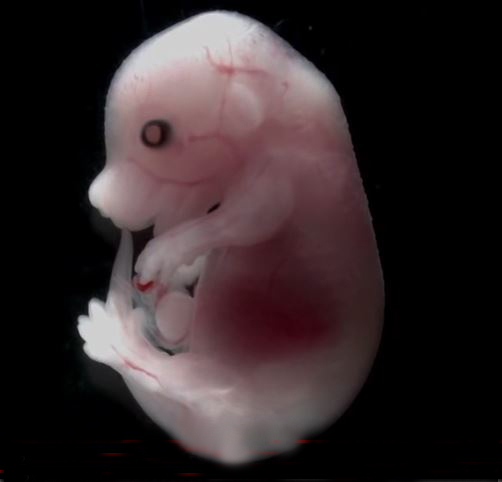Scientists have successfully delivered gene therapy directly to the brains of unborn mouse fetuses to treat a fatal, neuropathic form of the genetic metabolic disorder, Gaucher disease (GD). Tests in the mouse model of neuropathic GD showed that a single fetal intracranial injection of an adeno-associated viral (AAV) vector carrying the gene (GBA) for the missing glucocerebrosidase (GCase) kickstarted enzyme production in the brain, which held back neurodegeneration, and allowed the mice to survive after birth, and even reproduce. The team also demonstrated the feasibility of delivering vectors directly into target areas of the brain in a fetal non-human primate, the macaque.
“This new approach will bring hope, not only for GD, but also for other inborn errors of metabolism that can potentially be treated using fetal gene therapy,” claims Jerry Chan, Ph.D., associate professor and senior consultant, department of reproductive medicine, KK Women’s and Children’s Hospital, Singapore, who is co-author of the team’s published paper in Nature Medicine, which is titled, “Fetal gene therapy for neurodegenerative disease of infants.”
GD is an irreversible, inherited genetic disorder caused by mutations in the GBA gene. The gene defect means cells don’t produce the lysosomal enzyme GCase, which is normally responsible for breaking down glucocerebroside lipids. This lack of enzyme means that fat-laden Gaucher cells build up in the spleen, liver, bone marrow, and nervous system, causing bone disease, anemia, fatigue, eye problems, seizures, and brain damage. GD has various forms, and can sometimes be managed using enzyme replacement therapy. “In adult patients, the milder form presents with hepatomegaly, splenomegaly and occasional lung and bone disease,” the authors explain. “ … this is managed, symptomatically, by enzyme replacement therapy.” In contrast, the acute, childhood form of nGD causes early-onset, irreversible neurodegeneration that is lethal and untreatable, because the administered enzyme can’t cross the blood–brain barrier.
“Being able to provide therapy at the earliest possible opportunity is vital in treating the brain which has a limited capacity to regenerate,” comments senior author, Ahad Rahim, Ph.D., lecturer in translational neuroscience, at University College London (UCL) School of Pharmacy.
The researchers developed a human AAV-GBA gene therapy construct, which they delivered directly into the brains of mouse nGD fetuses. Encouragingly, while untreated control animals developed neurodegenerative symptoms that led to death by day 15 after birth the in utero-treated animals all appeared normal, were fertile, and demonstrated normal brain levels of GCase activity. “We found that the mice who received an injection of adeno-associated virus (AAV) vector were more able to break down fatty chemicals and re-express the gene encoding an enzyme that is deficient in Gaucher disease,” explains corresponding author, Simon Waddington, M.D., reader in gene transfer technology and acting director of the UCL Institute for Women’s Health. “The mice who received the injection in utero, lived for up to at least 18 weeks after birth compared to 15 days in untreated mice and had no signs of neurodegeneration and were fertile and fully mobile.
Further tests showed that administering gene therapy intravenously to newborn animals instead of to fetuses also resulted in some benefits, but the postnatal therapy wasn’t as effective as direct intracerebroventricular delivery in utero. “Neonatal intervention also rescued mice but less effectively,” Dr. Waddington adds.
Normalization of GCase activity in the brain following in utero intracerebroventricular gene delivery did not completely eliminate disease pathology, as the treated animals developed visceral disease. Interestingly in utero vector administration via intracerebroventricular injection didn’t prevent Gaucher cell infiltration in spleen, liver, and lungs, whereas postnatal intravenous therapy did prevent spleen enlargement and Gaucher cell infiltration in spleen, liver, and lungs. “Therefore, while intracerebroventricular gene therapy is effective in treating the lethal neuropathology, it does not ameliorate the visceral manifestations,” the authors write. “However, intravenous administration effectively limits both neurological and visceral pathology.”
In a final set of experiments the team successfully used transabdominal ultrasound to guide delivery of a fluorescence-tagged AAV9 viral vector directly to the cerebral ventricles of macaque fetuses, demonstrating the potential to carry out direct delivery of gene therapy to the fetal brain in a model that more closely mirrors humans. “Macaques and humans share a very similar neurological, immunological and physiological developmental timeline in the womb, making them accurate models for preclinical investigations before clinical trials can proceed,” Dr. Chan comments. “We have used a clinically relevant method to deliver the GBA gene using AAV vectors to the brain efficiently.”
“Widespread gene delivery to the central nervous system by fetal intracranial injection offers the best therapeutic potential for inherited early-onset neurodegenerative diseases affecting the whole brain,” the authors state. “ … the non-human primate data offer a clinically feasible protocol for its implementation. This, and other preclinical fetal gene therapy studies, address the suggested requirements of the NIH recombinant DNA advisory committee, namely safety and efficacy in relevant models for progression to clinical trials.”






